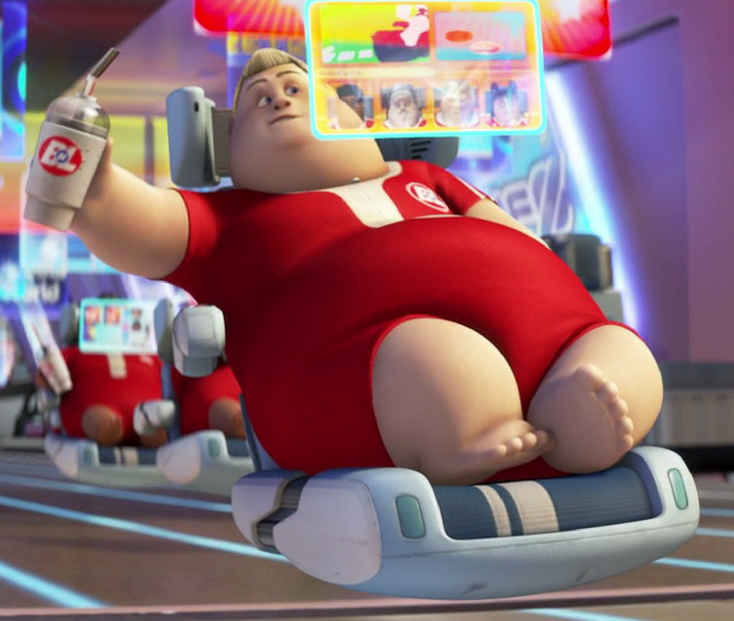This article delves into the portrayal of "fat people" in Pixar's animated film Wall-E, a crucial topic that sparks discussions about obesity, consumerism, and environmental issues. In a world where media representation significantly influences societal perceptions, Wall-E stands out for its bold commentary on human behavior and its consequences. The film’s depiction of overweight characters serves as a metaphor for deeper societal problems, including the consequences of an overindulgent lifestyle. This article will explore these themes in detail, shedding light on their relevance in today's context.
The narrative of Wall-E, while primarily centered around a small waste-collecting robot, subtly weaves in themes of environmental neglect and the impact of sedentary lifestyles on health. The depiction of humans in the film, specifically their physical forms, raises critical questions about personal responsibility, societal pressures, and the future of humanity. Through this exploration, we aim to uncover the underlying messages that Pixar intended to communicate through these representations.
As we navigate through the various aspects of Wall-E's portrayal of overweight characters, we will examine the statistics surrounding obesity, its socio-economic implications, and the cultural narratives that shape our understanding of body image. This comprehensive analysis will provide readers with a nuanced perspective on the film’s themes and their relevance in contemporary society.
Table of Contents
- 1. The Concept of Obesity in Wall-E
- 2. Biographical Overview of Wall-E
- 3. The Characters: A Closer Look
- 4. Societal Implications of the Film
- 5. Analyzing the Environmental Message
- 6. Cultural Perspectives on Obesity
- 7. Statistics and Data on Obesity
- 8. Conclusion: What Can We Learn?
1. The Concept of Obesity in Wall-E
In Wall-E, the representation of overweight characters serves as a cautionary tale about the dangers of consumerism and neglecting personal health. The film illustrates a future where humanity has become excessively reliant on technology, leading to a sedentary lifestyle that contributes to obesity. This portrayal invites viewers to reflect on their own lifestyles and the potential consequences of their choices.
2. Biographical Overview of Wall-E
Wall-E, released in 2008, is a Pixar animated film directed by Andrew Stanton. The film tells the story of a small trash-compacting robot, Wall-E, left to clean up an abandoned Earth. As the last of his kind, Wall-E's adventures lead him to discover a new purpose and ultimately, the fate of humanity.
| Title | Wall-E |
|---|---|
| Director | Andrew Stanton |
| Release Date | June 27, 2008 |
| Production Company | Pixar Animation Studios |
3. The Characters: A Closer Look
The film features a range of characters, particularly focusing on the humans who embody a lifestyle marked by excess. Their physical appearances, characterized by obesity, are exaggerated to emphasize the film's critique of consumer culture. This portrayal raises important questions about how society views and treats individuals with obesity.
3.1 The Humans in Wall-E
The humans in Wall-E are depicted as entirely dependent on technology, leading to a life of passivity and indulgence. Their large sizes reflect their lack of movement and reliance on automated systems, serving as a visual representation of the consequences of their choices.
3.2 Wall-E's Contrast with Humans
In contrast, Wall-E, the protagonist, is small and hardworking. His industrious nature highlights the stark differences between him and the humans, reinforcing the idea that personal effort and responsibility are essential for a healthy life.
4. Societal Implications of the Film
Wall-E presents a powerful commentary on contemporary societal issues, particularly related to obesity and health. The film’s depiction of overweight characters serves as a mirror reflecting the realities of modern life—where convenience often trumps health.
5. Analyzing the Environmental Message
One of the most significant messages of Wall-E relates to environmental degradation. The film illustrates how neglecting our planet can lead to dire consequences, paralleling the neglect of personal health and well-being. The connection between environmental sustainability and personal responsibility becomes evident, prompting viewers to reconsider their choices.
6. Cultural Perspectives on Obesity
The representation of obesity in Wall-E also opens a dialogue about cultural attitudes towards body image. Society often stigmatizes individuals with obesity, leading to discrimination and marginalization. Wall-E challenges these perceptions by portraying its overweight characters in a nuanced manner, encouraging empathy rather than judgment.
7. Statistics and Data on Obesity
To further understand the implications of obesity as depicted in Wall-E, it's important to look at relevant statistics. According to the World Health Organization (WHO), worldwide obesity has nearly tripled since 1975. In 2022, over 1.9 billion adults, 18 years and older, were overweight, and of these, over 650 million were classified as obese.
- In the United States, the obesity rate is approximately 42.4% among adults.
- Obesity is linked to various health issues, including heart disease, diabetes, and certain cancers.
- The economic impact of obesity in the U.S. is estimated to be over $147 billion annually.
8. Conclusion: What Can We Learn?
In conclusion, Wall-E serves as a profound commentary on the consequences of consumerism, environmental neglect, and the societal attitudes towards obesity. Through its portrayal of overweight characters, the film encourages viewers to reflect on their lifestyles and the broader implications of their choices. By understanding the messages conveyed in Wall-E, we can foster a more compassionate and responsible society.
We invite readers to share their thoughts on the themes presented in this article. What do you think about the portrayal of obesity in media? Leave a comment below, and feel free to share this article with others who might find it insightful. Additionally, explore other articles on our site for more discussions on impactful films and societal issues.
Thank you for reading! We hope this article has provided you with valuable insights and encourages you to return for more engaging content.


